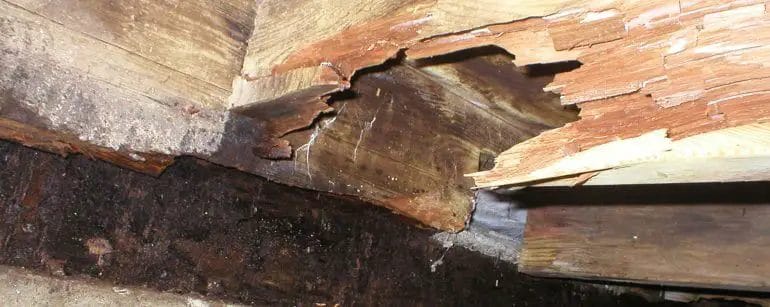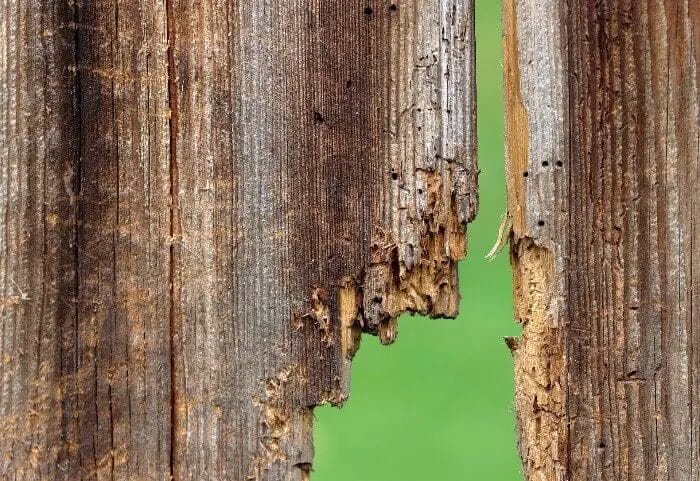Treated wood is specifically designed to resist rotting and decay, making it an excellent choice for outdoor projects or areas with high moisture. The wood is treated with chemicals that penetrate the fibers, providing long-lasting protection against fungal growth and insect damage. This treatment enhances the wood’s durability and lifespan, ensuring that it remains strong and intact even in harsh environmental conditions. Whether it’s for a deck, fence, or other outdoor structures, treated wood offers peace of mind and a long-lasting investment.

Factors Affecting Rot Resistance in Treated Wood
When it comes to using wood in outdoor applications, one of the biggest concerns is rot. Rot can deteriorate wood and significantly reduce its lifespan. However, with the use of treated wood, the rot resistance can be greatly improved. Treated wood is wood that has been infused with preservatives to protect it from fungal decay, insects, and other elements that can cause rot. But what are the factors that affect the rot resistance of treated wood? Let’s take a closer look.

1. Type of Wood
The type of wood used plays a crucial role in determining the rot resistance of treated wood. Different species of wood have varying levels of natural resistance to decay. For example, cedar and redwood are known to have high natural resistance to rot, making them ideal choices for outdoor applications. On the other hand, pine and fir have lower natural resistance and require more extensive treatment to improve their rot resistance.
2. Treatment Method
The method used to treat the wood also affects its rot resistance. There are several treatment methods available, including pressure treatment, dip treatment, and vacuum treatment. Pressure treatment is the most common method and involves placing the wood in a pressure vessel and forcing the preservative into the wood fibers under high pressure. This method ensures deep penetration of the preservative, resulting in better rot resistance.
3. Type of Preservative
The type of preservative used in the treatment process is another important factor. Different preservatives have different levels of effectiveness against rot. Common preservatives used for treating wood include copper-based compounds, such as ACQ (Alkaline Copper Quaternary) and CA (Copper Azole), as well as organic compounds like borates. These preservatives provide long-lasting protection against rot, fungi, and insects.
4. Moisture Content
Moisture is one of the main factors that contribute to rot in wood. Even treated wood can rot if it is constantly exposed to high levels of moisture. Therefore, controlling the moisture content of the wood is crucial for preventing rot. This can be achieved by ensuring proper drainage, using sealants or coatings to protect the wood from water, and regularly inspecting and maintaining the wood to identify any areas of concern.
5. Environmental Conditions
The environmental conditions in which the treated wood is exposed also play a role in its rot resistance. Wood that is constantly subjected to high humidity, extreme temperatures, or direct contact with water will be more susceptible to rot. Proper installation and maintenance practices, such as providing adequate ventilation and keeping the wood away from direct ground contact, can help prolong the lifespan of treated wood.
6. Quality of Treatment
The quality of the treatment process itself is a critical factor in determining the rot resistance of treated wood. The wood must be properly treated and the preservative must be evenly distributed throughout the entire piece of wood. Inadequate treatment or uneven distribution of the preservative can result in areas of the wood being more susceptible to rot.
Summary
When it comes to rot resistance in treated wood, several factors come into play. The type of wood, treatment method, type of preservative, moisture content, environmental conditions, and quality of treatment all affect the overall rot resistance of the wood. By considering these factors and implementing proper installation and maintenance practices, you can ensure that your treated wood has maximum rot resistance and a longer lifespan.

How Does Treated Wood Stand Up Against Rot Compared to Untreated Wood?
Wood is a versatile and widely used construction material due to its strength, durability, and aesthetic appeal. However, wood is susceptible to rot when exposed to moisture, which can significantly reduce its lifespan and structural integrity. To combat this issue, wood can be treated with various chemicals to enhance its resistance to rot. In this section, we will delve into the topic of how treated wood performs against rot compared to untreated wood.
Untreated wood, while cost-effective and readily available, is highly vulnerable to rot. When exposed to moisture over an extended period, untreated wood absorbs water, leading to swelling and eventual decay. Rot is caused by fungi that thrive in moist environments, breaking down the wood fibers and causing structural damage. Furthermore, untreated wood is also prone to insect infestation, which further accelerates the process of decay.
On the other hand, treated wood is specially treated with preservatives to improve its resistance to rot and decay. These preservatives can be applied through various methods, such as pressure treatment, dip treatment, or vacuum treatment. The most commonly used preservatives for treated wood include copper-based compounds, such as copper azole, alkaline copper quat, and copper boron azole. These compounds penetrate the wood, creating a barrier against rot-causing fungi and insects, thus extending the lifespan of the wood.
Treated wood has proven to be highly effective in preventing rot when compared to untreated wood. The preservatives used in the treatment process significantly reduce the wood’s ability to absorb moisture, making it less susceptible to fungal growth and decay. Additionally, treated wood is more resistant to insect infestation, as the preservatives act as a deterrent to wood-boring insects.
It is important to note that while treated wood provides enhanced protection against rot, it is not entirely immune to decay. Over time, the preservatives may leach out of the wood, particularly in areas of high moisture. Therefore, regular maintenance, such as reapplication of preservatives or sealing the wood with a protective coating, is necessary to ensure long-term durability.
In summary, treated wood offers superior resistance to rot compared to untreated wood. The application of preservatives significantly reduces its susceptibility to moisture absorption, fungal growth, and insect infestation. By choosing treated wood for construction projects, you can enhance the longevity and structural integrity of your wooden structures.

Signs of Wood Rot in Treated Wood: How to Identify and Address the Issue
Treated wood is commonly used in various outdoor construction projects due to its resistance to decay and insect damage. However, even treated wood can fall victim to a common problem known as wood rot. Wood rot can compromise the structural integrity of the wood and lead to costly repairs if not addressed in a timely manner. In this section, we will discuss the signs of wood rot in treated wood and provide guidance on how to identify and address this issue.
1. Discoloration
One of the first signs of wood rot in treated wood is discoloration. The affected area may appear darker or discolored compared to the surrounding wood. This discoloration is often accompanied by a soft, spongy texture when touched. If you notice any unusual discoloration on your treated wood, it is important to investigate further to determine if wood rot is the cause.
2. Foul Odor
Another indicator of wood rot in treated wood is a foul odor. As the wood decays, it can emit a musty or damp smell. If you detect a strong odor coming from your treated wood, it is a clear sign that there is a moisture issue and potential wood rot. The odor may become more pronounced when the wood is damp or in humid conditions.
3. Crumbling or Softened Wood
When wood rot sets in, the affected area may become soft, crumbly, or weakened. If you notice that your treated wood feels soft or crumbles easily when touched, it is likely that wood rot is present. This deterioration of the wood’s structure can compromise its strength and make it susceptible to further damage.
4. Presence of Fungi or Mold
Fungi or mold growth is a common sign of wood rot. In some cases, you may see visible patches of fungi or mold on the surface of the treated wood. These growths often appear green, black, or white in color and may have a fuzzy or slimy texture. If you observe any fungal or mold growth on your treated wood, it is essential to address the wood rot issue promptly.
How to Address Wood Rot in Treated Wood
Once you have identified signs of wood rot in your treated wood, it is crucial to take appropriate action to address the issue. Here are some steps you can follow:
- Assess the extent of the damage: Carefully inspect the affected area to determine the scope of the wood rot. Identify how far the rot has spread and whether it has compromised the structural integrity of the wood.
- Remove the damaged wood: Safely remove the affected wood using appropriate tools such as a chisel, saw, or pry bar. Be sure to wear protective gear and exercise caution during the removal process.
- Treat with a wood preservative: Once the damaged wood has been removed, apply a wood preservative to the remaining healthy wood to prevent further rot and decay.
- Repair or replace: Depending on the extent of the damage, you may need to repair or replace the affected section of the treated wood. Follow appropriate construction techniques and use treated wood materials.
- Maintain proper drainage and ventilation: To prevent future instances of wood rot, ensure proper drainage and ventilation around your treated wood structures. Avoid direct contact with the ground and provide adequate airflow to minimize moisture buildup.
By promptly identifying and addressing wood rot in treated wood, you can protect the longevity and structural integrity of your outdoor construction projects. Regular inspections and maintenance can help prevent wood rot and prolong the life of your treated wood materials. Remember to consult with a professional if you are unsure about the extent of the damage or if you require assistance in addressing wood rot issues.
Rot-Proofing Treated Wood: Best Practices for Long-Term Durability
Treated wood is a popular choice for outdoor projects due to its resistance to rot and decay. However, while treated wood is designed to withstand the elements, it is not completely immune to rot over time. To ensure the long-term durability of treated wood, it is important to take certain precautions and follow best practices for rot-proofing. In this section, we will discuss some of the top tips and techniques for rot-proofing treated wood.
1. Proper Installation
The first step in rot-proofing treated wood begins with proper installation. It is important to ensure that the wood is installed correctly and securely to minimize the risk of moisture infiltration. This includes using the appropriate fasteners, such as stainless steel or hot-dipped galvanized nails, screws, or bolts, which are resistant to corrosion. Additionally, providing adequate spacing between boards allows for better air circulation and helps prevent moisture from getting trapped between them.
2. Seal the Ends
The ends of treated wood are particularly susceptible to moisture penetration and rot. To combat this, it is recommended to seal the ends of the wood with an end-cut preservative. This product helps to protect against water absorption and minimizes the chances of rot starting from the exposed ends. Be sure to follow the manufacturer’s instructions when applying the end-cut preservative for optimal results.
3. Apply a Water Repellent
Applying a water repellent to the surface of the treated wood can help further protect it from moisture damage. Water repellents create a barrier that prevents water from being absorbed into the wood, reducing the risk of rot and decay. There are various types of water repellents available, such as oil-based or water-based options. Choose a water repellent that is specifically formulated for use on treated wood and follow the application instructions provided by the manufacturer.
4. Regular Maintenance
Maintaining the condition of treated wood is essential for its long-term durability. Regularly inspect the wood for any signs of damage or wear and address them promptly. Apply a fresh coat of water repellent every few years to maintain the protective barrier. Additionally, keep the wood clean and free from debris to prevent moisture buildup and potential rot. Taking proactive measures to maintain the treated wood will help extend its lifespan and prevent costly repairs down the line.
5. Proper Drainage
Ensuring proper drainage around treated wood structures is crucial to prevent moisture accumulation. Poor drainage can lead to water pooling around the wood, increasing the risk of rot. To improve drainage, consider grading the surrounding area away from the wood and installing a suitable drainage system, such as a French drain. This will help redirect water away from the wood and reduce the likelihood of moisture-related issues.
6. Avoid Direct Ground Contact
Avoiding direct ground contact is another important practice for prolonging the durability of treated wood. When possible, elevate the wood above the ground using concrete footings, piers, or other suitable supports. This helps prevent moisture from seeping into the wood and reduces the chance of rot. If direct ground contact is unavoidable, consider using a barrier, such as a waterproof membrane or gravel, to provide a protective layer between the wood and the ground.
In summary, rot-proofing treated wood is crucial for ensuring its long-term durability. By following best practices such as proper installation, sealing the ends, applying a water repellent, regular maintenance, ensuring proper drainage, and avoiding direct ground contact, you can significantly reduce the risk of rot and extend the lifespan of your treated wood projects. Remember to consult with professionals or refer to the manufacturer’s guidelines for specific recommendations and techniques.
FAQs
Does treated wood rot?
No, treated wood is specially treated with preservatives to make it resistant to rot, decay, and insect infestation. However, over time, if the treatment wears off or the wood is exposed to extreme conditions, it can still be susceptible to rot. Regular maintenance and reapplication of treatment can help prevent this.
Conclusion
In conclusion, treated wood is highly effective in preventing rotting. Through the process of treatment, the wood is infused with chemicals that act as a barrier against rot-inducing factors such as moisture, insects, and fungi. This treatment significantly enhances the wood’s durability and lifespan, making it an ideal choice for various outdoor applications such as decking, fencing, and landscaping projects.
Additionally, the use of treated wood can save homeowners and businesses from expensive repairs and replacements caused by rotting. Its resistance to decay ensures that structures remain strong and stable for an extended period. Therefore, investing in treated wood can provide long-lasting and reliable solutions for construction and outdoor project needs.
Overall, treated wood offers a reliable and cost-effective solution to minimize rotting and prolong the life of wooden structures, ensuring both functionality and aesthetic appeal.
